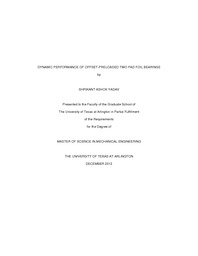
ATTENTION: The works hosted here are being migrated to a new repository that will consolidate resources, improve discoverability, and better show UTA's research impact on the global community. We will update authors as the migration progresses. Please see MavMatrix for more information.
Show simple item record
| dc.contributor.author | Yadav, Shrikant Ashok | en_US |
| dc.date.accessioned | 2013-07-22T20:15:52Z | |
| dc.date.available | 2013-07-22T20:15:52Z | |
| dc.date.issued | 2013-07-22 | |
| dc.date.submitted | January 2012 | en_US |
| dc.identifier.other | DISS-12057 | en_US |
| dc.identifier.uri | http://hdl.handle.net/10106/11911 | |
| dc.description.abstract | Commercial application of the air foil bearing (AFB) in microturbomachinary have been acknowledged. Absence of external pressurizing and lubricating system makes them light and compact. Simple construction, low friction drag and reliability at high speed operations are few more advantages of the AFBs. With all these advantages AFB proves to be the suitable option for oil-free small turbomachinery which includes micro gas turbines with shaft power less than 1000hp. Micro gas turbine generators are typically two shaft configuration with power generation capacity less than 500KW. Although many micro gas turbines with AFBs have been developed, due to the proprietary nature of their bearings, no specific information about shape and configuration of the bearings is available. This work presents the dynamic performance of offset-preloaded two pad foil bearings, which is designed and developed for the sponsor project. The scope of the sponsor project was to design journal bearings and thrust bearings for 12KW gas turbine operating at rated engine speed of 138,000 rpm. At this high speed operation, rotor stability is an important issue. From the previous research, it is known that bearings with multi pad configurations are more stable than single pad configuration. Hence, an offset-preloaded two pad bearing configuration was selected for further developed for the sponsor project. Dynamic performance of the bearing was investigated by calculating frequency-dependent stiffness coefficients and damping coefficients. And the stability analysis for cylindrical mode was performed by determining modal impedances; where positive modal damping over all frequency is interpreted as a stable rotor-bearing system. A code developed by Dr. Kim, which implements the perturbation method for evaluating the frequency-dependent force coefficients is used for this purpose. The geometric and operational parameters are the input for this code. The bump stiffness and structural damping loss factor of the bump foil was evaluated from load-deflection tests, which were used as input parameter to the simulation. In addition to original designed orientation, dynamic performance of the bearing was evaluated for various clocked orientations like +/- 90 degrees and +/- 45 degrees. Results indicated that at all the clocked orientations, the bearing is stable. Hence, unlike single pad circular foil bearings, this offset-preloaded two pad bearing is stable at any clocked orientation. This novel feature of the offset-preloaded two pad bearing makes it possible to install the bearing in any orientation. | en_US |
| dc.description.sponsorship | Kim, Daejong | en_US |
| dc.language.iso | en | en_US |
| dc.publisher | Mechanical Engineering | en_US |
| dc.title | Dynamic Performance Of Offset-preloaded Two Pad Foil Bearings | en_US |
| dc.type | M.S. | en_US |
| dc.contributor.committeeChair | Kim, Daejong | en_US |
| dc.degree.department | Mechanical Engineering | en_US |
| dc.degree.discipline | Mechanical Engineering | en_US |
| dc.degree.grantor | University of Texas at Arlington | en_US |
| dc.degree.level | masters | en_US |
| dc.degree.name | M.S. | en_US |
Files in this item
- Name:
- Yadav_uta_2502M_12057.pdf
- Size:
- 1.496Mb
- Format:
- PDF
This item appears in the following Collection(s)
Show simple item record


